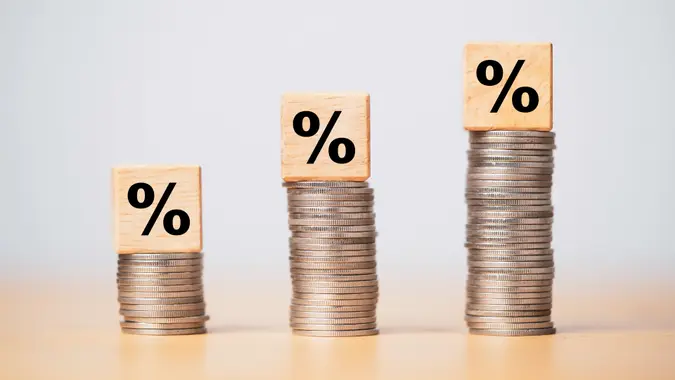If I Have $250K, How Much Should I Put In Savings?

Commitment to Our Readers
GOBankingRates' editorial team is committed to bringing you unbiased reviews and information. We use data-driven methodologies to evaluate financial products and services - our reviews and ratings are not influenced by advertisers. You can read more about our editorial guidelines and our products and services review methodology.

20 Years
Helping You Live Richer

Reviewed
by Experts

Trusted by
Millions of Readers
If you’ve got $250,000, congratulations! Saving that amount of money is tough, but certainly doable. How do people save that money once they’ve earned it, though? It’s a question worth considering, especially as you think about how much money you’ll need to live your everyday life and also to meet any financial goals you’ve set for yourself.
If you’re wondering about how much income $250,000 will make and how much of it you should live on, here’s a deep dive into some strategies to help you figure it all out.
Read: Pocket an Extra $400 a Month With This Simple Hack
How Much of $250K Should You Save?
If you have $250,000, following the guideline of keeping an emergency fund that covers three to six months of living expenses means you should allocate approximately 3.6% to 7.2% of the total amount to your savings.
For example, if your monthly expenses are $3,000, aim for a savings fund of $9,000 to $18,000. This translates to setting aside about $9,000 (3.6% of $250,000) to $18,000 (7.2% of $250,000) in a savings account. This percentage provides a secure financial buffer while allowing the majority of your funds to be available for other investments or expenditures that align with your financial goals.
10 Tips for Managing Your $250K in Savings
Take a look at these tips if you need help with putting your savings in the right place.
1. Assess Your Financial Situation
First and foremost, assess your current financial situation. What are your monthly expenses? Do you have any debts? What are you hoping to achieve in the short term? How about long-term? Answering these questions can give you a clear view of where you stand and what you need to prioritize.
2. Keep an Emergency Fund
With an emergency fund that covers between three to six months of living expenses, you’ll have money to act as a financial buffer against unforeseen circumstances like job loss, medical emergencies or a surprise home repair. If your monthly expenses are $3,000, for example, aim for an emergency fund between $9,000 and $18,000.
3. How To Determine the Income Potential of $250K
Investing a portion of your $250, 000 can generate income, depending on the investment vehicle you choose. Consider a conservative approach, assuming a 4% annual return–a common benchmark in retirement planning known as the 4% rule. This rate could potentially yield $10,000 per year, or about $833 per month. Remember, investment returns are not guaranteed and can fluctuate.
4. How To Balance Savings and Investment
After setting aside your emergency fund, the next step is to consider how much of the $250,000 you want to invest. Investing can range from conservative options like bonds or high-yield savings accounts to more aggressive strategies like stocks or mutual funds. Your choice should align with your risk tolerance and financial goals.
5. How Much of $250K Should You Live On?
Living on a portion of your $250,000 depends on your lifestyle needs, expenses and income. If you’re using this money as a supplementary income, calculate how much you need monthly and plan accordingly. For example, if your regular income covers most of your expenses and you only need an additional $1,000 per month, you’d require $12,000 per year. This means you could set aside a portion of the $250,000 to generate this income through investments.
6. Why Long-Term Financial Planning Matters
Consider your long-term financial goals. Are you saving for retirement, a home purchase, or your children’s education? Allocating a portion of your $250,000 toward these goals can be a wise decision. For instance, if retirement is your goal, contributing to a retirement account like an IRA or a 401(k) can be beneficial, especially if they offer tax advantages.
7. The Role of a Financial Advisor
If you’re unsure about how to allocate your funds, consulting a financial advisor can be incredibly helpful. They can provide personalized advice based on your financial situation, goals, and risk tolerance.
8. The Importance of Diversification in Investments
Diversification is key in managing risk in your investment portfolio. Don’t put all your eggs in one basket. Spread your investments across different asset classes and sectors to lessen some of the risk.
9. Keep an Eye on Inflation
Inflation can erode the purchasing power of your savings over time. Consider investments that have the potential to outpace inflation, like stocks or real estate, as part of your portfolio.
10. Don’t Forget About Taxes
Be mindful of the tax implications on your investments. Different investment vehicles are taxed differently.
Final Take
Deciding how much of your $250,000 to save versus how much to live on is a balancing act that requires careful consideration of your financial situation, goals, and risk tolerance. Remember, there’s no one-size-fits-all answer. It’s about finding the right balance that works for you.
By being thoughtful and strategic about how you allocate your $250,000, you can maximize its potential to provide financial security and meet your life goals. Remember, every financial decision you make today shapes your financial future.
Editor's note: This article was produced via automated technology and then fine-tuned and verified for accuracy by a member of GOBankingRates' editorial team.
 Written by
Written by  Edited by
Edited by 

























